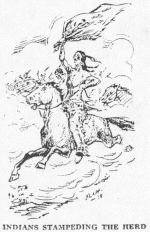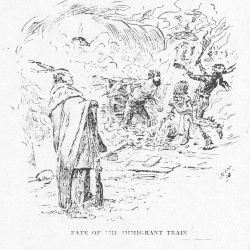 |
Sheridan County WYGenWeb Project
|
 |
Search This SiteBirth, Death, and Marriage Records Books and Lookups Immigration and Naturalization Mailing Lists, Surname Registries, and Message Boards |
Building Fort Phil Kearney
|
|||||
 |
Recover the Stampeded Stock. Evidently the mules and horses thought it was no fit country for them. We had had some trouble an hour or so previously in getting them to ford the Powder River, but they went back over it as thought it were dry land. The animals that were picketed pulled their pins, the hobbled ones, and even the stock the herders were riding, all stampeded. The herders finally stopped their horses two or three miles from where they started. A company of cavalry from Fort Reno (the herders) trailed the herd all night and it was overtaken at Pumpkin Buttes, some 45 miles from the fort. We got the stock back the next evening. |
If there had been a few Indians with their spears and buffalo robes they could easily had a herd of 600 or 700 head of horses and mules, and it is extremely doubtful if Fort Phil Kearney and Fort C. F. Smith would have been built had this happened.
I was detailed the next day to help load some wagons with provisions from the storerooms at Reno. The warerooms were built of cottonwood logs, chinked and daubed with mud, and
having dirt roofs. Some or the daubing had dropped out and snow had drifted in. The dirt roofs also leaked and added to the dirty mess. (The soldiers made great improvements in that fort in the Summers of l866 and 1867.)
We loaded up some sacks of bacon. I do not know how old it was but the fat had commenced to sluff off from the lean, and it was from three to five inches thick. There was a lot of flour in the storerooms and the mice had tunneled thru it and the bacon evidently for some time.
Third day of July was payday and we received four months' pay. There was some bootlegging, but very little drunkenness in those days. One method I saw here for punishing drunkenness was on this day, and one of the worst cases of cruelty I saw in the Army. At the guard tent four stakes were driven into the ground and the drunken soldier was stretched at full length and tied to them. This was called the "Spread Eagle."
The sun was beating down on him when I saw him and I thought he was dead. Flies were eating him up and were running in and out of his mouth, ears, and nose. It was reported that he died, but in the Army one can hear all kinds of reports. I only saw that one case but heard they started the same thing at Fort Reno a month or two later and caused a riot or mutiny. The commander gave the soldier his discharge as a compromise.
Our next camp was "Crazy Woman," and was reached after marching for 23miles on a very hot day with no water except that we carried. The water was found to be very bad after we reached the North Platte, with the exception of one camp _ I believe they called it Browns Springs. Most of the water was impregnated with alkali, which had a bad effect on lots of the men.
Many of the soldiers had bad feet owing to being forced to wear woolen socks in the hot weather, but no other kind was issued. Add to this the fact that there was only one ambulance available for sick soldiers, as the women and children had all the others in use, and you have a picture it of what it meant for a soldier to be sick.
After crossing Crazy Woman we found a wide bottom land on the north side, and the road entered a long ravine, coming out on top of the divide going towards Buffalo Wallow. This was a bad place and the Indians killed several people there during our stay in the country, stripping, mutilating, and scalping the bodies.
They may still be buried there, as we dug holes along the side of the road and dropped the bodies in, covering them with rocks when possible to keep the wolves and wolverines from digging them up. Sometimes an Indian would dig the body, and drag it down to the road.
The next bad place was Buffalo Wallow. Several had been killed there also _ immigrants, citizens, and soldiers. We buried them, and at every camp ground from Fort C. F. Smith on there are one or more bodies. Buffalo Wallow and Crazy Woman, however, were the two worst places between Fort Reno and Fort C. F. Smith.
We arrived at the forks of the Big and Little Pineys the 13th or 14th of July. For some reason they picked out a location about seven miles from the timber and from five to eight miles from any hay bottom.
A Federal judge who had been a judge of one of the territories was with us. I believe he had something to do with selecting the location of the fort as he and his partner had a bull train. The judge was a man who was surely "on to his job." He was a good diplomat. He made love to men, women, and children and lived at the fort most of the time. His partner ran the teams.
About the middle of July Fort Phil Kearney was staked out. Up to the 17th of July we hadn't seen an Indian and had commenced to think the threat of Red Cloud at Fort Laramie was just a bluff, but the rest of that Summer from July 17, 1866, and continuously thereafter until July 14, 1868, he was on the job. There was hardly a day passed at Fort Phil Kearney up to Dec. 21, 1866 (the date of the massacre), that we did not see Indians, and the others at Forts Reno and C. F. Smith had about the same experience.
 |
Run Off "Dead Herd." The usual order of the day was to make a forced march to the relief of some immigrant or freight train. In most cases the Indians had taken their toll and gone before we arrived. On July 17 the Indians killed an Indian trader at Peno Valley, about four miles north of Phil Kearney. The Indians killed French Pete Gayzous and his five men, ransacked his wagons and stripped, scalped, and mutilated his men. He was married to a Sioux squaw. She hid in the bushes until the soldiers rescued her. She was at the fort for about two months and left one night. |
'The same day the Indians ran off what we called our "Dead Herd." They were mules and horses that had sore necks, sore backs, or were crippled. Some were crippled at the stampede a few days before. It took several men all day to drive them from one camping ground to another 15 to 20 miles away. That day also three men were wounded and two killed. One man, John Donovan, of my company, was wounded twice, once with a poisoned arrow. One of the men received an arrow wound and another a bullet wound.
When the herd stampeded they ran across the Pineys and we could scarcely see them for the cloud of dust they raised. The mounted men followed until nearly dark, but only found four dead animals.
About July 20 Orderly Sergeant Lang of my company and I bought two fresh cows from an immigrant train. No one wanted to work in the kitchen, so I volunteered in order to be able to take rare of the cows morning and evening. It was not known that I had any interest in the cows or it might have caused some trouble.
Flour at $100 a Sack.
We had a first-class baker in the company who volunteered to do the baking and cooking. At
that time the Government did not furnish cooks or bakers. They simply furnished the
rations and the soldier could cook them himself or eat them raw as he saw fit. They
furnished no vegetables, We cooked soup, bacon. and coffee, and dished it out to the men
in their cups and plates - we had no dining room.
We boiled everything. I believe the bacon would have killed the men if it had not been thoroughly boiled. As it was it surely came near to it that winter. During the Winter of 1866 and 1867 the bacon and flour I had seen at Reno was given to us. The flour had been hauled 65 miles and handled several times. The result was that the refuse left by the mice was well mixed with the flour and we found a number of dead mice in it also.
As we could not get a sieve we manufactured one out of a burlap sack by pulling out some of the strings and nailing it on a wooden frame. We got most of the larger refuse out. The bacon, where the fat had commenced to sluff off from the lean, was yellow with age and bitter as quinine. Some of the worst we shaved off, but we could not spare too much. One reason why our rations were so scanty was that flour was worth $100 per sack. and bacon, coffee, and beans proportionately.
The companies of those times had no Quartermaster or Commissary Sergeants, and two or three men would be detailed to go and get the rations. They were piled out, in a heap and you could take them or leave them.